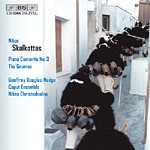
Concerto No 3 for Piano and Ten wind Instruments / The Gnomes (ballet)
 $33.29
Out of Stock
$33.29
Out of Stock6+ weeks add to cart
NIKOS SKALKOTTAS
Concerto No 3 for Piano and Ten wind Instruments / The Gnomes (ballet)
Geoffrey Douglas Madge (piano) / Caput Ensemble / Nikos Christodoulou
[ BIS / CD ]
Release Date: Wednesday 15 March 2006
This item is currently out of stock. It may take 6 or more weeks to obtain from when you place your order as this is a specialist product.
"Skalkottas's most ambitious work in two committed, insightful performances"
(Gramophone)
"Skalkottas's most ambitious work in two committed, insightful performances
Nikos Skalkottas's centenary is the right year for one of his major works to receive a first commercial outing. The Third Piano Concerto (1939) appears in complementary readings – allowing access to a piece that, since its 1969 premiere by three different pianists, has enjoyed notoriety on account of its sheer scale. But more remarkable is its economy of instrumentation: just 10 wind instruments (no doublings) and three percussion – their contributions mainly limited to formal punctuation and emphasis.
The duration of the three movements is a striking factor when considering the recordings: that by Geoffrey Douglas Madge lasts nearly 66 minutes, that by Danae Kara just over 54 minutes. Madge is disciplined and studious, though never calculated; Kara is more inclined to spontaneous gestures, with greater interplay with the ensemble. The opening Moderato – with its gradual coming-together of the thematic material for piano and wind – is trenchantly articulated by Madge, but Kara's forward impetus gives it greater overall cogency; and her more flowing tempo for the Andante sostenuto makes it formally and expressively all of a piece. That said, it is Madge who brings greater intensity to the later stages of the movement and finds exquisite pathos in the coda, while a more even sustaining of momentum in the Allegro giocoso finale enables him to wrap up the coda's harmonic and rhythmic summation of the themes with consequently greater emotional resolve.
Both the Caput Ensemble and the members of the Montpelier National Orchestra are as finely attuned to the requirements of Skalkottas's wind writing as they are to the distinct nature of their pianists' approaches. The BIS sound is very much a chamber-music focus, integrating piano firmly within the ensemble in the manner of Berg's Chamber Concerto; spacious but not unfocused (a pity about one or two awkward edits). The Decca recording has more of an orchestral ambience – recalling more the example of Stravinsky's Concerto for Piano and Wind. These pieces, together with Weill's Violin Concerto, are the antecedents in terms of musical context – but, as in all the works of his maturity, Skalkottas's idiom is his alone in terms of its stylistic integration and expressive intensity.
As to couplings, BIS offers the recently rediscovered score assembled in 1939 for a Christmas ballet on a Greek fairy-tale: drawing on Stravinsky and especially Bartók, as well as traditional music, these witty vignettes attest to Skalkottas's inherent versatility. Decca provides the first recording of the Piano Concertino – written at a time (1948) when Skalkottas was aiming at a more tonally direct approach, yet without sacrificing sophistication of musical means. Anyone who responds to Bartók's Third Concerto, or that by Poulenc, will enjoy making its acquaintance. As part of BIS's impressive edition, the Madge disc has to be the central recommendation, but both releases are valuable in making available one of Skalkottas's most ambitious works in committed and insightful performances."
(Gramophone)

